May 17, 2025 | 19:54 GMT +7
May 17, 2025 | 19:54 GMT +7
Hotline: 0913.378.918
May 17, 2025 | 19:54 GMT +7
Hotline: 0913.378.918
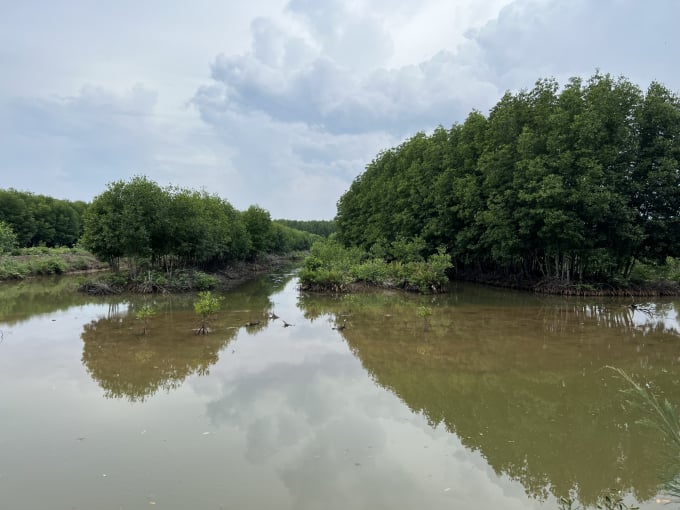
Mangrove forest in Ngoc Hien, Ca Mau. Photo: Trong Linh.
Ngoc Hien is the last district on the map of Vietnam, where Ca Mau - the southernmost point of the country Cape is located. This is also the place of the largest mangrove forest in Vietnam with an area of more than 35,000 ha. This mangrove forest is entirely located in Ca Mau Cape Biosphere Reserve recognized by UNESCO in 2009. And today, the last land of the country has achieved a new feat: Vietnam’s largest eco-organic black tiger shrimp farming area under mangroves.
Talking about the miracle today, we should also need to be reminded a little about the past. It is said that shrimp farming under mangroves appeared on this cape land more than twenty years ago. It was a period of turbulence. Shrimp farming was very profitable, so farmers expanded their shrimp farming area by narrowing the forest area. They even used tricks like smashing the tree trunk and then blamed it on rat bites. Strangely, when the forest met an “unusual” death, the shrimp farming industry died with it. It took a long time before people realized shrimp only lived when the forest is protected.
That was when the role of collective economy came into play. According to Director of Ca Mau Department of Agriculture and Rural Development Phan Hoang Vu, its biggest effect was to change people’s perception and awareness of sustainable development together. Cooperatives, cooperative groups, shrimp farming associations were born not only to produce together but also to connect and associate with large enterprises for export. 195 agricultural cooperatives, 790 cooperative groups, and 1 cooperative union had formed an enormous collective economic community.
Among them, the model of Minh Phu Mangroves Social Enterprise (Minh Phu Mangroves) was a prime example with a total area of nearly 10,000 ha and more than 2,000 farming household members in 3 communes of Vien An Dong, Vien An and Dat Mui of Ngoc Hien district. In June 2021, the Vietnam Record Organization (VietKings) officially set a record as followed: “Minh Phu Mangroves Social Enterprise - Owner of Vietnam’s largest eco-organic black tiger shrimp farming area under mangroves.”
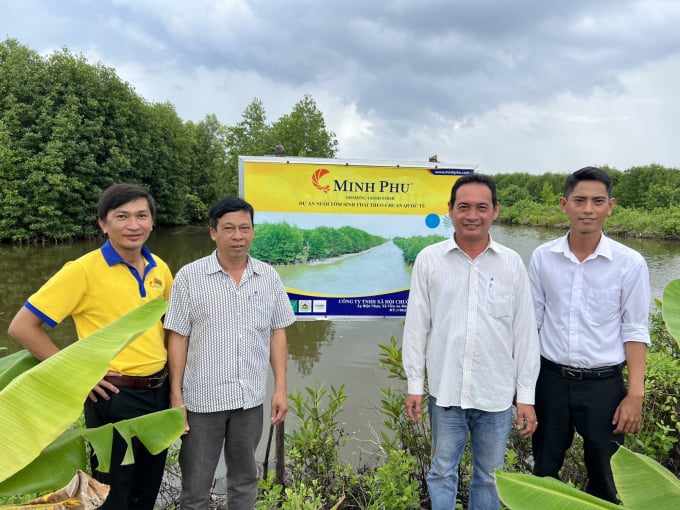
The shrimp farming in mangrove model of Minh Phu Mangroves Social Enterprise. Photo: Trong Linh.
Minh Phu Mangroves Social Enterprise is under Minh Phu Seafood Corporation - the unit that established the first organic shrimp projects in 2013 with the name “Eco-Certification Department”. Later born at the beginning of 2017, Minh Phu Mangroves’s goal is to contribute to society and the environment specifically in the mangrove forest in Ngoc Hien district.
Project leader Duong Vu Phong said, "So far the project has built three key ecological shrimp farming areas including the communes of Vien An, Vien An Dong and Dat Mui with a total area of nearly 10,000 hectares, along with more than 2,000 members. The enterprise and local people are currently building the original organic shrimp brand according to Naturland international standards. It is clear that once the benefits are confirmed, the story of people changing to connect and develop sustainably together has also become much easier.”
The change Mr. Phong mentioned is evident in two aspects.
Firstly, shrimp farmers in Ngoc Hien now perceive and think very differently compared to several years ago. They know how to create a label and organize production to meet market standards.
For example, the mandatory standard of Naturland certification is that shrimp farming must not affect mangroves, farmers must ensure a forest cover rate of 40% or more per pond area, and no harmful chemicals are allowed. Shrimp farmed in the mangrove must have clear origins. Farmers have to both raise and participate in the management and protection of mangroves and wild animals listed in the Red Book. They must pay close attention to inputs, breeding stock, and issues concerning waste.
It is important for farmers to keep a record of all activities related to shrimp farming (improvement, trash removal, stocking, harvesting, etc.) and other activities (raising livestock, poultry, growing crops) in the diary. All documents and records must be saved in accordance with regulations for a period of 5 years (contract, farm diary, invoice for seed purchase). In addition, domestic waste must be collected and treated appropriately so as not to directly pollute the ponds and the environment.
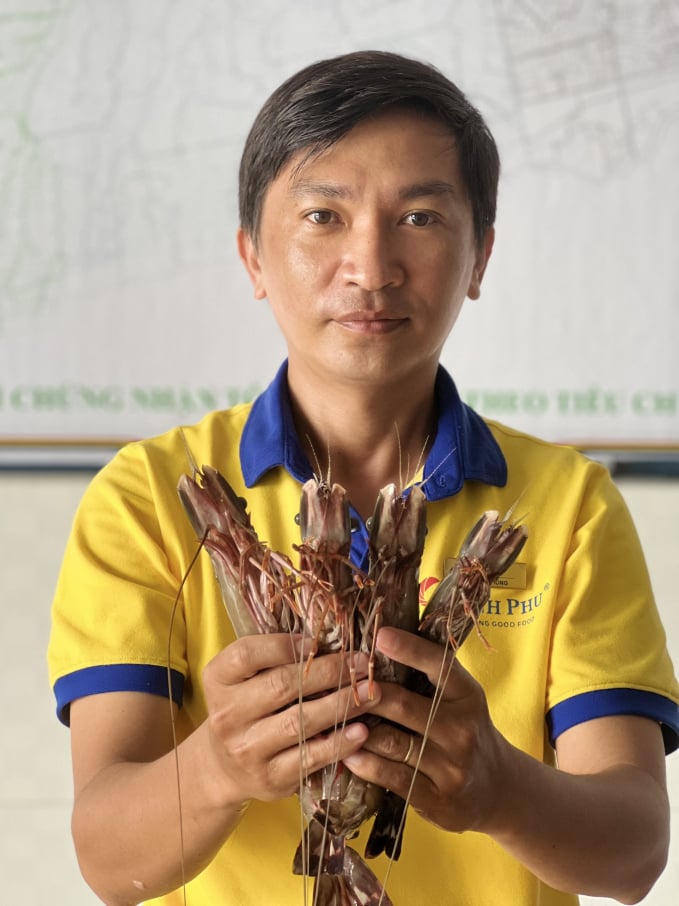
Eco-shrimp farming under mangroves is not as productive as industrial shrimp farming but possesses many other benefits in terms of economy and environment. Photo: Trong Linh.
Secondly, not only securing economic efficiency, but eco-shrimp farmers also benefit from forest environmental services. Thanks to Minh Phu Mangroves’ shrimp farming model, people will be able to consume products at a higher price than the market. Households with ecological certification are also supported with 20,000 seeds/year. When the projects are fully certified, people will enjoy the benefits in terms of payment for forest environmental services at the rate of VND 500,000/ha and an added value of approximately VND 3,000/kg of product.
“The project has opened a new path for shrimp farmers in Ngoc Hien to make a breakthrough and take a step forward, develop sustainable livelihoods for shrimp farming communities, contribute to raising awareness of environmental protection and mangrove development, preserve and develop forest shrimp farming traditional profession, build a brand image and enhance ecological and organic shrimp as a specialty of high quality,” said Mr. Phong.
When I asked the people in Ngoc Hien what eco-forest shrimp was, they said, “It is a type of shrimp that grows in nature, meaning that it is raised on the surface of water covered by natural forest, unafraid of drought, salt intrusion or seasonal rains like industrial shrimp. Now Ngoc Hien eco-forest shrimp proudly enters the most demanding markets such as the USA, Japan or the EU.”
And to my knowledge, this story originated at the end of the last century. There was a delegation of the Swiss Embassy led by the Ministry of Fisheries to visit Ca Mau. During a meal under the mangrove canopy, the wild shrimp were brought to treat the guests. The shrimps then immediately “went abroad”.
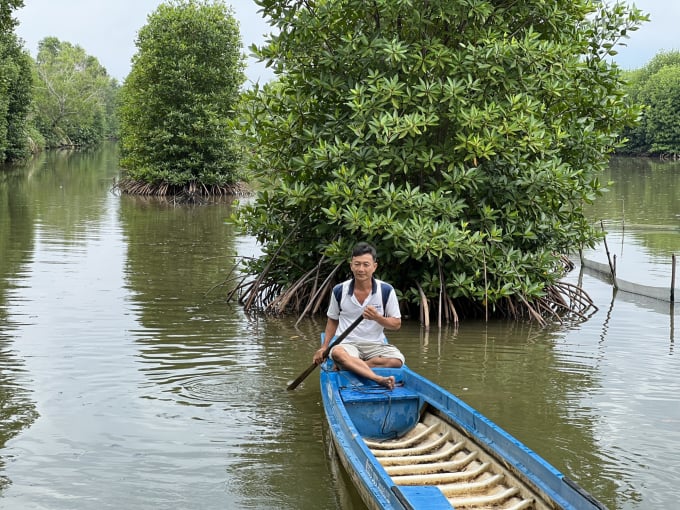
Elder farmer Ngo Thanh Hien. Photo: Trong Linh.
"Blissful" is Mr. Ngo Thanh Hien, 50 years old, living in Ong Trang hamlet, Vien An commune, Ngoc Hien district used after participating in the ecological shrimp farming model today.
Mr. Hien's household has more than 4 ha of forest shrimp farming area. In the past, when raising the shrimps using traditional farming, the family’s income was relatively stable. But after a few years, the water environment showed signs of being polluted. Productivity increasingly decreased, there were times he even lost a whole crop without knowing what to do.
“Since switching to ecological forest shrimp farming, I have gained some new benefits.” Ecological forest shrimp farming is not only 10-20% more profitable than the traditional method, but the procedure is absolutely safe as well. This is now the best job as he almost has no need to use machines, or do any heavy work. The family members can use their time for other work and still have a stable income of approximately VND 200 - 220 million/year.
And to Vice Chairman of Ca Mau People's Committee Le Van Su, the words are “firm and sustainable”.
Developing collective economy, cooperatives, and cooperative groups on this cape land starts from practical needs, goes from low to high, and thus achieves firm and positive results. The forest shrimp models in Ngoc Hien and Nam Can are now closed production chains, not only creating outputs of high economic value but also contributing to changing people's perception and awareness about sustainable and responsible agriculture.
That eco-forest shrimp production chain is taken care of from the selection of seed. The production organization considers both economic development and forest protection, meeting quality standards by being mindful of the market and customers as well as the responsibility for future generations. People adore forests and shrimp ponds like flesh and blood.
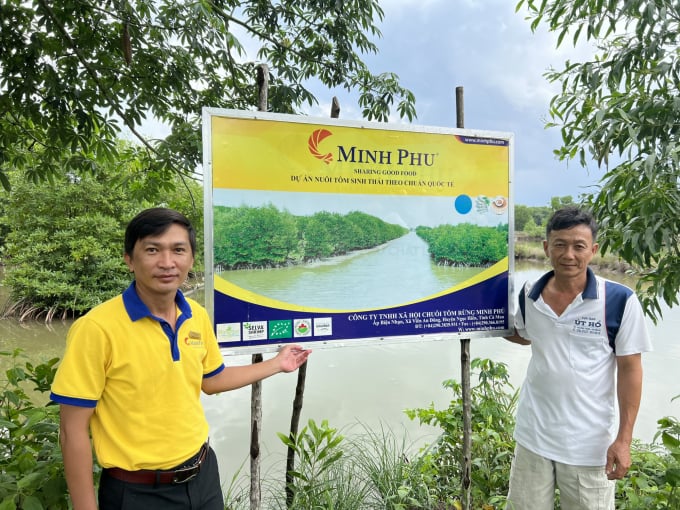
Collective economy is changing the face of Ca Mau the cape land. Photo: Trong Linh.
In the collective economic community on Ca Mau, Minh Phu Mangroves Social Enterprise holds the center position to connect the people, cooperatives and cooperative groups to “develop together, ‘doing good things’ together.”
Translated by Samuel Pham

(VAN) Muong Nhe Nature Reserve hopes that being upgraded to a national park will lay the foundation for forest protection efforts to be carried out in a systematic, modern, and sustainable manner.
/2025/05/16/3923-2-171845_52.jpg)
(VAN) Lower costs, higher yields, and improved soil quality are outstanding benefits that soybeans bring when integrated into the crop rotation system.
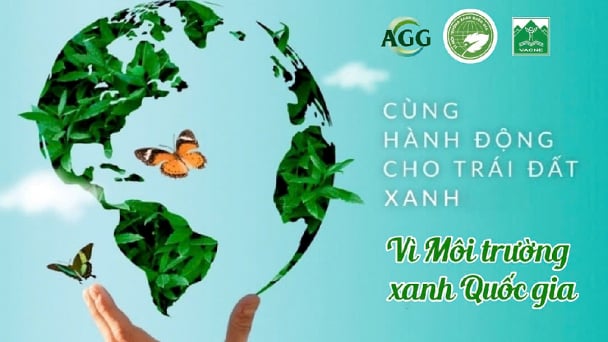
(VAN) The 'For a Green National Environment' programme aims to promote a green lifestyle, support businesses in implementing ESG practices, and turn Net Zero commitments into concrete actions.

(VAN) Cold-barn systems efficiently manage environmental and temperature conditions, which aids in the prevention of respiratory diseases in pigs and protects them from the vectors that transmit African swine fevers.

(VAN) To tackle challenges, the project 'Addressing key technical bottlenecks in the grouper supply chain in Vietnam' has been underway since 2024.

(VAN) The project 'Disease-Resilient and Sustainable Cassava Production Systems in the Mekong Region', funded by the Australian Center for International Agricultural Research (ACIAR), is being implemented from 2024 to 2028.

(VAN) Data from 10,000 farming households will help professionalize production organization and support the implementation of the One Million Hectares Program for High-Quality, Low-Emission Rice Cultivation.